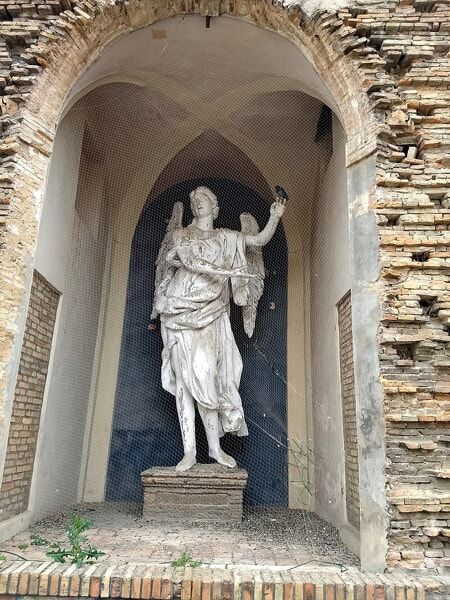That “void” in via Dall’Aste a stone’s throw from Piazza Saffi, now used as a car park, underlies a drama dating back to the last world war, which has remained in the shadows. In Forlì, on the external wall of the monastery of the Poor Sisters of Santa Chiara, in Piazzetta Garbin, there is a marble slab with the names of the 20 victims (including three children, a priest and a Poor Clare nun) of the German air bombing of 10 December 1944, which canceled the fifteenth-century church of San Biagio in San Girolamo and the masterpieces of Melozzo degli Ambrogi contained in the Feo Chapel.
That tragic afternoon 80 years ago (it was a Sunday), the Lutwaffe did not limit itself to amputating from the Forlì body the only testimony of Melozzi’s genius present in the city, but did much, much more. Antonio Mambelli writes in his diaries: “Four German Focke-Wulf 190 F8s, each equipped with a Grossladungsbombe SB 1000 type bomb fitted with an AZ 55 A fuze to detonate it before impact with the ground, dropped their 2,200 kilogram load on San Biagio and in Corso Diaz on the Prati, Albicini, Dall’Aste and Merenda buildings”. If San Biagio was destroyed by mistake (the real objective was the very nearby Monti ice house, located in the former monastery of Santa Chiara, which had just become a logistics depot for the British Army), in the very central artery dedicated to the general who on 4 November 1918 had brought the Royal Italian Army to victory over the Austro-Hungarians, the attack was fully successful: the bomb in fact devastated Palazzo Merenda, which housed the headquarters of the English, who had liberated Forlì a month earlier.
“The bomb – writes Giuliano Missirini in his Narrated Guide to Forlì – created a void from the courtyard of Palazzo Prati to Via Caterina Sforza: in total 40 English soldiers died, plus 26 civilians, including an entire family unit of 7 people”. “Thirteen British soldiers – confirms Mambelli on 11 December – bodies were found in a room on the ground floor of Palazzo Merenda, so the number of soldiers killed would exceed forty”. The eighteenth-century Palazzo Brandolini Dall’Aste was described in 1927 by Ettore Casadei, who in his Guide to Forlì and its surroundings celebrates the “very rich family archive, containing documents relating to it, from the century. XII to the century. XVIII. In the chapel of the palace, in addition to many relics, the body of the martyr St. Boniface, two catacomb tombstones, the mask of St. Philip Neri and two autographs of St. Francis de Sales and St. Charles Borromeo are kept. Part of the Dall’Aste documentation was saved, as it had previously been entrusted to the cultural institutes of Forlì. In 1947, the Cinema Teatro Astra was built on the ruins of the ancient building, which was in turn replaced in 2000 by the Teatro Diego Fabbri. The German bombs also caused tremendous damage to Palazzo Savorelli Prati, pulverizing much of the collection of paintings, crystal, ceramics and Louis XVI style furniture kept inside.
74 works survive, mainly from the regional, Venetian and Roman context, dating from the mid-15th century to the end of the 19th. In addition to the paintings, the palace displays a set of furniture (tables, chairs, armchairs, sofas, chests of drawers), majolica (plates, trays, cups, lids) and chandeliers of Italian craftsmanship. The historical archive of the Institute is very important, consisting of 1,250 units including registers, envelopes and files, dated from 1320 to 1944 and located on shelves in the room which also houses the library, a small collection of coins (from the Roman age to end of the 18th century) and the collection of prints, the latter also heavily damaged by the bombing. In what was once the internal garden of the palace, now occupied by a car park with access from via dall’Aste, there is a niche, probably the remains of a vegetable garden with a cross vault, in which there is a large statue dating back to the 18th century, in white painted wood, depicting Saint Michael the Archangel. It remains to be said about the other two “Grossladungsbombs” dropped on Forlì that day and left unexploded: one would have ended up in the basement of the Maldenti Houses, the other on the area of the Orsi Mangelli factory.












